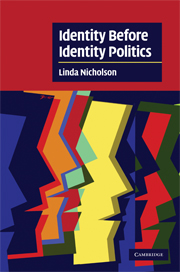Book contents
- Frontmatter
- Contents
- Acknowledgements
- Introduction
- 1 The politics of identity: race and sex before the twentieth century
- Introduction to chapters 2 and 3
- 2 Freud and the rise of the psychological self
- 3 The culture concept and social identity
- Introduction to chapters 4 and 5
- 4 Before Black Power: constructing an African American identity
- 5 Womem's identity/women's politics
- Epilogue: identity politics forty years later: assessing their value
- Index
- Cambridge Cultural Social Studies
4 - Before Black Power: constructing an African American identity
Published online by Cambridge University Press: 17 July 2009
- Frontmatter
- Contents
- Acknowledgements
- Introduction
- 1 The politics of identity: race and sex before the twentieth century
- Introduction to chapters 2 and 3
- 2 Freud and the rise of the psychological self
- 3 The culture concept and social identity
- Introduction to chapters 4 and 5
- 4 Before Black Power: constructing an African American identity
- 5 Womem's identity/women's politics
- Epilogue: identity politics forty years later: assessing their value
- Index
- Cambridge Cultural Social Studies
Summary
In the mid 1960s, the slogan “Black Power” burst forth upon the US political stage, expressing an important transformation in African American politics. That politics, previously focused on the elimination of legalized segregation and discrimination, became something more. African Americans were no longer only demanding rights to work, eat, go to school, and reside where they wished; now black people were also expressing a pride in being black and a demand for greater control over black life. The phenomena associated with “Black Power” were complex: Black Panthers organizing breakfast programs for children; middle-class African Americans wearing African-style clothing and Afro haircuts; college students asking for the creation of African American Studies programs; residents of inner city neighborhoods calling for community control of school districts. But all of these phenomena seemed to possess at least certain elements in common: a pride in being black and a belief that this pride should organize African American political, institutional, and personal life.
The identity this pride expressed was new. While it shared features with forms of identity that had existed within African American communities prior to the 1960s, it was not quite identical to these earlier forms of identity. From the middle of the nineteenth to the middle of the twentieth century, two forms of identity were most open to African Americans.
- Type
- Chapter
- Information
- Identity Before Identity Politics , pp. 94 - 138Publisher: Cambridge University PressPrint publication year: 2008

